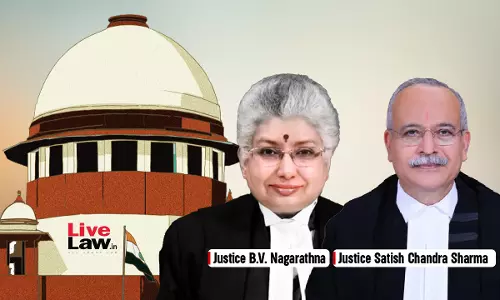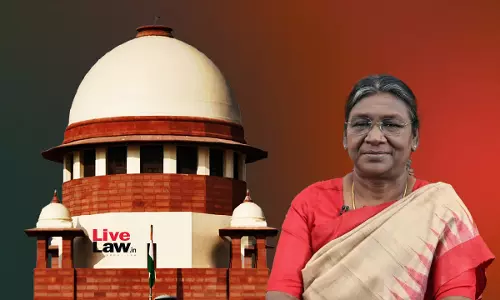Evolving a uniform sentencing policy is a tough call; Supreme Court [Read Judgment]
![Evolving a uniform sentencing policy is a tough call; Supreme Court [Read Judgment] Evolving a uniform sentencing policy is a tough call; Supreme Court [Read Judgment]](https://www.livelaw.in/cms/wp-content/uploads/2015/04/Supreme-Court-of-India.jpg)
A two Judge Bench of the Supreme Court has held that determining the adequacy of sentence to be awarded in a given case is not an easy task, just as evolving a uniform sentencing policy is a tough call. Justices T.S. Thakur and Gopal Gowda by separate but concurring opinions, had ordered the release of an Accused, who was convicted by Delhi High Court for offence punishable under Section 8...
A two Judge Bench of the Supreme Court has held that determining the adequacy of sentence to be awarded in a given case is not an easy task, just as evolving a uniform sentencing policy is a tough call. Justices T.S. Thakur and Gopal Gowda by separate but concurring opinions, had ordered the release of an Accused, who was convicted by Delhi High Court for offence punishable under Section 8 of the Prevention of Corruption Act, 1988 and reduced sentence awarded by the Trial Court from 2 years to 1 year retaining Rs.5000/- fine imposed, with default sentence of 2 months, with the sentence already undergone.
In his separate opinion Justice Thakur held as follows;
Determining the adequacy of sentence to be awarded in a given case is not an easy task, just as evolving a uniform sentencing policy is a tough call. That is because the quantum of sentence that may be awarded depends upon a variety of factors including mitigating circumstances peculiar to a given case. The Courts generally enjoy considerable amount of discretion in the matter of determining the quantum of sentence. In doing so, the courts are influenced in varying degrees by the reformative, deterrent and punitive aspects of punishment, delay in the conclusion of the trial and legal proceedings, the age of the accused, his physical/health condition, the nature of the offence, the weapon used and in the cases of illegal gratification the amount of bribe, loss of job and family obligations of accused are also some of the considerations that weigh heavily with the Courts while determining the sentence to be awarded. The Courts have not attempted to exhaustively enumerate the considerations that go into determination of the quantum of sentence nor have the Courts attempted to lay down the weight that each one of these considerations carry. That is because any such exercise is neither easy nor advisable given the myriad situations in which the question may fall for determination. Broadly speaking, the courts have recognised the factors mentioned earlier as being relevant to the question of determining the sentence. Decisions of this Court on the subject are a legion. Reference to some only should, however, suffice.
Justice Thakur relied on B.G. Goswami v. Delhi Administration (1974) 3 SCC 85, where the accused was convicted under Section 5(2) read with Section 5(1)(d) of the Prevention of Corruption Act, 1947 and under Section 161 of I.P.C and was sentenced to undergo rigorous imprisonment for a period of 1 year and 4 months. On appeal, Supreme Court while reducing the punishment to the period already undergone, laid down the general principles that are to be borne in mind by the Courts while determining the quantum of punishment.
He also relied on Dologovinda Mohanty v. State of Orissa (1979) 4 SCC 557, where the Supreme Court upon considering the negligible amount of Rs. 138/- alleged to have been received by the accused as illegal gratification, took a lenient view by reducing the sentence of the accused from four months rigorous imprisonment to the period already undergone.
Read the Judgment here.


![Offer Extended Till 15th April! 30% Discount On LiveLaw Academys Judicial Service Examination Preparation Course [Apply Now!] Offer Extended Till 15th April! 30% Discount On LiveLaw Academys Judicial Service Examination Preparation Course [Apply Now!]](https://www.livelaw.in/h-upload/2025/04/12/500x300_595581-lla-early-bird-750-x-450.webp)

